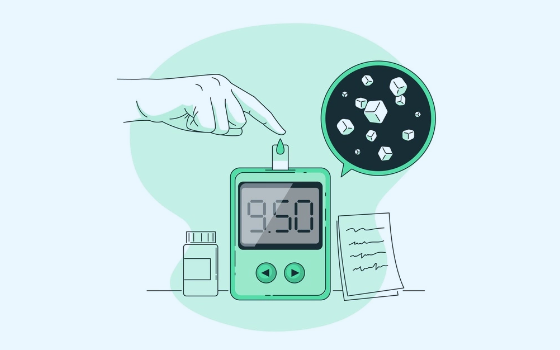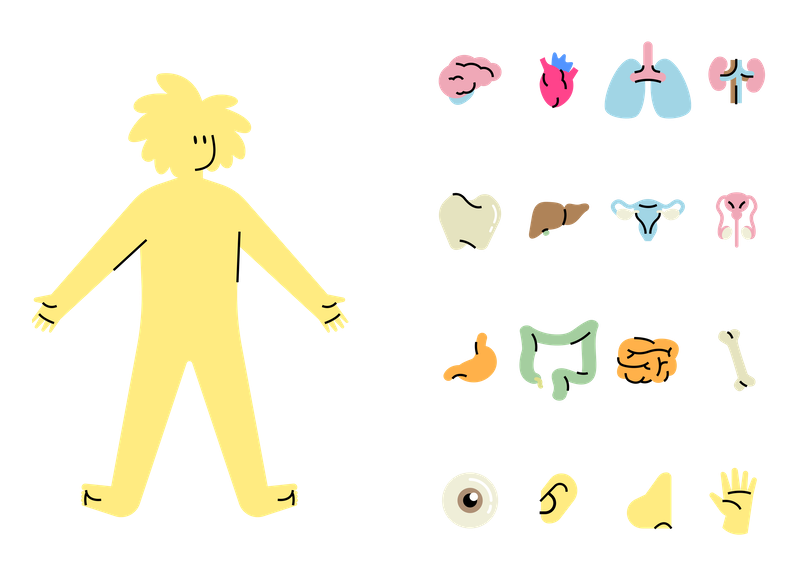CBD and Diabetes: Does CBD oil help with Diabetes?

Did you know that November is National Diabetes Month [¹]?
That’s right, thousands of communities and people across the country gather together to raise awareness about diabetes.
Now, there are many ways doctors address both Type 1 and Type 2 Diabetes. But it seems a lot of people are embracing the use of CBD oil for their diabetic symptoms.
In fact, there have been a few studies involving CBD and diabetes—some of which have shown a lot of promise.
But before we dive into those studies, let’s look at what the different types of diabetes are.
Type 1 vs Type 2 Diabetes
Type 1 diabetes is considered an autoimmune disorder . In other words, your body attacks itself by mistake by not making insulin. So, when you eat, the glucose from your food just sits in your bloodstream, causing damage to blood vessels and suffocating your cells from getting what they need to function properly [²].
Believe it or not, about 5-10% of people with diabetes are diagnosed with Type 1 Diabetes; the rest are Type 2 [³].
Type 2 diabetes is often developed over time and more commonly diagnosed in adults due to unhealthy lifestyles, bad eating, and obesity. It’s where your body struggles to use your insulin and normalize your blood sugar levels [²].
In other words, your body is no longer able to respond to the insulin your body naturally creates, thus causing what is known as insulin resistance.
You see, your body naturally produces a hormone called insulin through your pancreas whenever you eat. And it’s this hormone that helps regulate blood glucose levels and create energy .
Now, one major symptom of Type 2 Diabetes is inflammation throughout the body.
But there are many other symptoms that follow both types of diabetes.
Link to CBD and Autoimmune Disease: Can CBD oil help with autoimmune disease article.
Link to CBD for Energy: Do CBD gummies give you energy article
Symptoms of Type 1 and Type 2 Diabetes
One of the first symptoms of both types of diabetes is fatigue and inflammation.
Other symptoms include [²]:
Increased thirst and urination
Increased hunger
Blurred vision
Numbness or tingling in the feet or hands
Sores that don’t heal properly
Unexplained weight loss
Now, the symptoms of Type 1 Diabetes often start fairly quickly; literally it’s a matter of weeks until you’ll notice these symptoms. But Type 2 Diabetes does not develop quickly. It takes a long time and in many cases, Type 2 Diabetic symptoms go unnoticed.
Which brings us to the cause of Diabetes…
What causes Diabetes?
As we mentioned earlier, Type 1 Diabetes occurs when your immune system mistakenly attacks and destroys your body’s natural production of insulin, which then leads to your body no longer making insulin altogether.
Scientists are still working to understand what causes Type 1 Diabetes, but from their research they believe that genes, environmental factors like viruses, or even over-vaccination can lead to a disruption of immunity and insulin function [²].
As for Type 2 Diabetes, genes, lifestyle, obesity, and lack of physical activity can open the door for insulin resistance. In fact, research suggests that “extra belly fat is linked to insulin resistance, Type 2 Diabetes, and heart and blood vessel disease [²].”
That said, the main difference between Type 1 and Type 2 Diabetes is that Type 2 diabetes is preventable.
And while they both present the same general problem (having too much glucose flooding through your blood), they are treated very differently.
So…
How is Diabetes Treated?
Type 1 Diabetes is treated with an insulin pump. Since the body no longer creates insulin, you’ll need to inject insulin into your body to help break down your food properly and keep your body functioning normally [⁴].
Type 2 Diabetes is usually managed through healthy eating, physical exercise, and even through diabetic medications. In extreme cases, insulin may be required [⁴].
Now, the medications that are used to address Type 2 Diabetes have been shown to cause pretty significant side effects, like dizziness, muscle pain, severe drowsiness, slow or irregular heartbeat, stomach pain and diarrhea, nausea, difficulty breathing, tiredness, chills, and blue or cold skin [⁵].
Because of these, many people have opted for less invasive medicinal herbs and plant-derived nutrients to address their diabetic symptoms.
Which brings us to…
CBD Oil and Diabetes
Now, before we dive into the research surrounding CBD oil for diabetes, we need to make one point very clear… CBD is not a “cure-all”. It should never be used to treat or diagnose a serious health condition.
That said, many people have found a lot of comfort using CBD oil for their diabetic needs.
And here’s why…
The majority of the studies involving CBD often mention pretty powerful anti-inflammatory properties.
In fact, in one specific study, scientists explored CBD’s effects on the inflammation brought on from high glucose levels. What they found was that CBD had a positive effect on addressing the inflammation [⁶].
While researchers can’t conclusively say that CBD can reduce diabetic inflammation, this study has piqued their interest, and now more studies are underway to explore CBD’s effects on the possible damage diabetes may cause.
Now, there’s another study that found CBD to help reduce nerve pain and inflammation associated with osteoarthritis [⁷]. And as it turns out, people who suffer from arthritis often develop diabetes [⁸].
Again, more research is needed to confirm these findings, but it’s safe to say that this study does show promise.
Now, the last thing we want to mention is a 2015 study. In this study, researchers discovered a significant reduction in both inflammation and neurotoxicity in diabetic rats after administering CBD [⁹]. This resulted in a positive outlook in CBD’s future. (Of course, more studies are needed on humans.)
And here’s some even better news… It seems the Endocannabinoid System and plant-derived cannabinoids can help with diabetic complications. In fact, one study found that “CBD reduced the incidence of diabetes in nonobese diabetic mice, the mouse model of type 1 diabetes [¹¹].”
This same study found that CBD decreased levels of proinflammatory cytokines, showing it is “able to ameliorate the disease when given at the time of the development of initial symptoms of diabetes in nonobese diabetic mice [¹¹].”
Each of these studies reported no side effects from CBD, which is exciting. But this doesn’t mean that CBD is totally without side effects.
CBD Side Effects
You’ve likely heard it once and you’ll hear it a million times over… Every person is different!
Meaning, what works for one person, may not work for another person. So, just because CBD is effective in some people, doesn’t mean it will be effective for all people.
That said, there are a few possible side effects of CBD [¹⁰]:
Tiredness and exhaustion
Diarrhea
Changes of appetite and weight
Drug interactions
Potential effect on liver enzymes
Now, it’s important to note that while these side effects may seem alarming, they are rare and do fade rather quickly after discontinuing CBD.
Furthermore, the quality of your CBD oil or CBD gummies have a lot to do with how effective it can be when addressing your issues.
That said, nothing can really address your diabetic needs like adopting a healthy lifestyle, a clean diet, and proper daily exercise.
Which brings us to…
Diabetes Prevention
Now, we know that Type 1 diabetes is not preventable. In fact, the exact cause of Type 1 Diabetes is still unknown..
But Type 1 and Type 2 Diabetes symptoms can be managed. And as it turns out, the steps to manage diabetes are also the steps to prevent prediabetes.
In fact, did you know that 1 in 3 American adults are prediabetic? That’s 88 million people in the United States. And the worst part is, the majority of those people have no clue they’re on the brink of being diagnosed with diabetes [¹].
This is why diabetes awareness and prevention is key.
So, here are a few tips you can use to both manage and prevent diabetes [¹]:
First and foremost, choose healthier foods and drinks as often as you can. Whole foods, like fruits, vegetables, high quality proteins, carbohydrates, and omega 3 fats are the foundation to introducing balance back into your overall system. Also, stay hydrated with water. Steer clear from sugary drinks and snacks.
Next, maintain an active lifestyle. The more you keep moving, the better you’ll feel. But start slowly if you’ve been sedentary. Don’t jump right into hiking 5 miles a day. Start by walking 20 minutes at a time.
Maintain a healthy weight. Remember that obesity is an open door to diabetes. If you are overweight, you can join a gym, develop a routine, and track your weight loss journey. The more you can keep off the weight, the better you’ll feel and be able to possibly prevent diabetes.
Make sure you get enough sleep. Take a break from blue-light an hour before you head off to bed. Getting quality sleep helps recover your body’s natural functions.
Incorporate healthy herbs and medicinal supplements. A lot of plant-derived supplements and herbs contain anti-inflammatory properties. The more you can reduce your inflammation, the faster your body can recover.
Finally, seek support. If you are prediabetic, it never hurts to talk to someone. In fact, seeking counsel can help you move forward in the right direction.
Now remember: it’s important that you start slow. Trying to tackle all of these tips at once can be a bit overwhelming. By starting slow, you’re more likely to maintain these healthy habits in the long run. And be sure to give yourself a break if you endure a setback. Setbacks are normal!
How to use CBD for Diabetes
We recommend you follow the instructions and recommendations written on the label of your CBD product.
We also encourage you to consult with your doctor before you add CBD to your daily routine.
CBD is not a “cure-all” but it does contain therapeutic properties that have been shown to help numerous ailments.
Just be sure you’re only purchasing high quality CBD products. Steer clear from shady CBD brands that don’t value transparency. Look for third party testing, high quality hemp, and clean ingredients.
The more transparent the CBD brand is, the higher quality the CBD products will be.




